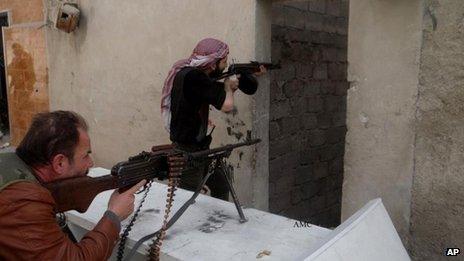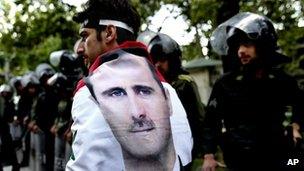Could Syria conflict become regional war?
- Published

The Syrian conflict has been steadily growing since March 2011
This week the leader of Hezbollah - the Shia movement in southern Lebanon - made it clear that he saw weapons transfers from Syria as a "strategic response" to the Israeli air strikes that hit the outskirts of Damascus last Sunday.
Hassan Nasrallah said that Hezbollah would receive "unique weapons that it never had before" - a strong assertion that the weapons transfers will continue.
So too may Israeli air strikes, with the risk that Israel and Hezbollah may become embroiled in a new round of fighting. So a crisis that began as a popular upheaval in Syria could degenerate into a bitter regional war.
In fact, the Syrian crisis is many battles rolled into one.
In part it is indeed a struggle for power between a Sunni majority and the minority Alawite leadership that has dominated the country for a generation.

Hassan Nasrallah said Hezbollah was ready to receive weapons that would "break the balance of forces"
This struggle - quite apart from provoking a humanitarian catastrophe - is taking on aspects of a more general sectarian and ethnic struggle with disturbing reports of massacres and ethnic cleansing, often perpetrated by pro-government militias.
Lebanon connection
But more than this, it also represents a broader strategic struggle for influence in the region as a whole, with Iran - Syria's closest ally - eager to prop up the government of President Bashar al-Assad for as long as possible.
Tehran also seems to be laying the groundwork for its future influence in a post-Assad Syria.
For Tehran, opposed by most pro-Western Sunni Arab governments in the region, Syria is not just a diplomatic partner but a steadfast ally in the struggle against Israel.
It offers the practical means by which Iran can reach out to like-minded groups in the region - notably Hezbollah in Lebanon and Hamas in the Gaza Strip.
The Lebanon connection is crucial to Iran's plans. Hezbollah with its large missile force carries a significant threat to Israel.

Israeli troops have recently staged a drill near the Syrian border
In military terms, Hezbollah acquitted itself well in its last major conflict with Israel. And while the Israel Defence Forces believes that it has learnt the lessons from that struggle, Hezbollah will - no doubt - also have learnt lessons of its own.
Its forces are disciplined, motivated and well-trained.
Iran has not just sought to assist President Assad with weapons and technical advice. Hezbollah fighters have also crossed into Syria to fight on the government's side against rebel forces.
And in return intelligence reports suggest that Syria is seeking to transfer ever more advanced weaponry to Hezbollah.
Iran strategy
This is Israel's chief concern as the violence in Syria shows no sign of abating.
It has spoken out against the potential delivery of what it calls "game-changing" weapons to Hezbollah. These are believed to include accurate long-range missiles; sophisticated anti-shipping missiles; or modern surface-to-air missiles that would hamper Israel's relative freedom of movement in Lebanon's skies.
Fears of a strengthened Hezbollah have prompted a number of Israeli air strikes against missile stores and possibly other targets - most recently earlier this month - which may hamper such efforts but are hardly likely to halt them.

Iran is a long-standing supporter of Syrian President Assad
For now it is the Israel-Hezbollah-Syria triangle that represents the most dangerous front where the Syrian crisis could spill over into regional war.
It is the mutually supporting relationship between Syria, Hezbollah, and Iran, along with Israel's response to it that is fuelling this potential escalation.
A recent report from the Institute for the Study of War - jointly published with the American Enterprise Institute - paints a detailed picture of just how deep Iran's involvement in Syria really is.
It notes that security co-operation between the two countries is long-standing. A number of Iranian technicians are thought to have been killed in an explosion at the al-Safir chemical weapons and missile facility in 2007.
But it is the detail of the alleged Iranian support for the Syrian regime since the start of the current crisis that is interesting.
This is thought to involve training in internal security and counter-insurgency operations provided by elements drawn from the Iranian Revolutionary Guard Corps - both the Quds Force and its ground forces.
US government documents indicate considerable intelligence support for Damascus coming from Tehran, with Iranian security experts providing valuable expertise in suppressing popular disturbances, and so on.
The report says that "aerial re-supply is the most critical component of Iranian material support to Syria". It cites US data on a variety of flights involving Iranian civil aircraft as well as Iranian and Syrian military transports.
A March 2011 seizure by the Turkish authorities of a cargo from an Iranian Iluyshin-76 cargo plane en route to Syria revealed crates of ammunition, rifles, machine guns and mortar shells.
Iran has also provided support to paramilitary groups inside Syria - here perhaps forging useful links that could be important should the Assad government fall.
The report also highlights the growing role of Lebanese Hezbollah in Syria. The organisation is taking an ever-more active role, which some experts fear could intensify the sectarian dimension in the conflict.
The document argues that Iran has a forward-looking strategy.
For its purposes the Syrian government does not need to retain all of Syrian territory for it to maintain an important influence in the region.
Its outreach to pro-government militias, it says, "can work to drive the convergence between the remnants of the Syrian Army and pro-government militias".
"This combined force", the report concludes, "allied with Lebanese Hezbollah and Shia militant groups can continue to compete for limited territory within Syria and ensure that Iran remains able to project the force necessary to provide strategic depth and deterrence".